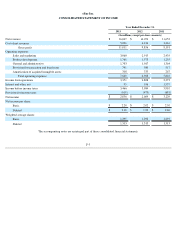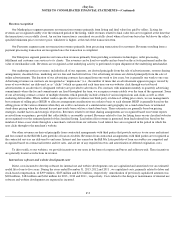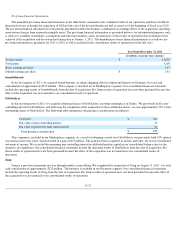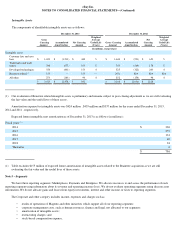eBay 2013 Annual Report Download - page 106
Download and view the complete annual report
Please find page 106 of the 2013 eBay annual report below. You can navigate through the pages in the report by either clicking on the pages listed below, or by using the keyword search tool below to find specific information within the annual report.
eBay Inc.
NOTES TO CONSOLIDATED FINANCIAL STATEMENTS—(Continued)
Revenue recognition
Our Marketplaces segment generates net transaction revenues primarily from listing and final value fees paid by sellers. Listing fee
revenues are recognized ratably over the estimated period of the listing, while revenues related to final value fees are recognized at the time that
the transaction is successfully closed. An auction transaction is considered successfully closed when at least one buyer has bid above the seller's
specified minimum price or reserve price, whichever is higher, at the end of the transaction term.
Our Payments segment earns net transaction revenues primarily from processing transactions for customers. Revenues resulting from a
payment processing transaction are recognized once the transaction is completed.
Our Enterprise segment generates net transaction revenues primarily from providing ecommerce technologies, order processing,
fulfillment and customer care services to its clients. The revenues can be fixed or variable and are based on the activity performed and/or the
value of merchandise sold. Revenues are recognized as the underlying activity is performed or upon shipment of the underlying merchandise.
Our marketing services revenues, included in all of our segments, are derived principally from the sale of advertisements, revenue sharing
arrangements, classifieds fees, marketing service fees and lead referral fees. Our advertising revenues are derived principally from the sale of
online advertisements. The duration of our advertising contracts has ranged from one week to five years, but is generally one week to one year.
Advertising revenues on contracts are recognized as “impressions” (i.e., the number of times that an advertisement appears in pages viewed by
users of our websites) are delivered, or as “clicks” (which are generated each time users on our websites click through our text-based
advertisements to an advertiser's designated website) are provided to advertisers. For contracts with minimum monthly or quarterly advertising
commitments where the fee and commitments are fixed throughout the term, we recognize revenue ratably over the term of the agreement. Some
of our advertising contracts consist of multiple elements which generally include a blend of various impressions and clicks as well as other
marketing deliverables. Where neither vendor-specific objective evidence nor third-party evidence of selling price exists, we use management's
best estimate of selling price (BESP) to allocate arrangement consideration on a relative basis to each element. BESP is generally based on the
selling prices of the various elements when they are sold to customers of a similar nature and geography on a stand-alone basis or estimated
stand-alone pricing when the element has not previously been sold on a stand-alone basis. These estimates are generally based on pricing
strategies, market factors and strategic objectives. Revenues related to revenue sharing arrangements are recognized based on revenue reports
received from our partners, provided that collectability is reasonably assured. Revenues related to fees for listing items on our classified websites
are recognized over the estimated period of the classified listing. Lead referral fee revenue is generated from lead referral fees based on the
number of times a user clicks through to a merchant's website from our websites. Lead referral fees are recognized in the period in which the
user clicks through to the merchant's website.
Our other revenues are derived principally from contractual arrangements with third parties that provide services to our users and interest
and fees earned on the Bill Me Later portfolio of loan receivables. Revenues from contractual arrangements with third parties are recognized as
the contracted services are delivered to end users. Interest and fees earned on the Bill Me Later portfolio of loan receivables are computed and
recognized based on contractual interest and fee rates, and are net of any required reserves and amortization of deferred origination costs.
To drive traffic to our websites, we provide incentives to our users in the form of coupons and buyer and seller rewards. These incentives
are generally treated as reductions in revenue.
Internal use software and website development costs
Direct costs incurred to develop software for internal use and website development costs are capitalized and amortized over an estimated
useful life of one to five years. During the years ended December 31, 2013, 2012 and 2011 , we capitalized costs, primarily related to labor and
stock-based compensation, of $299 million , $285 million and $212 million , respectively. Amortization of previously capitalized amounts was
$228 million , $184 million and $166 million for 2013 , 2012 and 2011 , respectively. Costs related to the design or maintenance of internal use
software and website development are expensed as incurred.
F-9
























